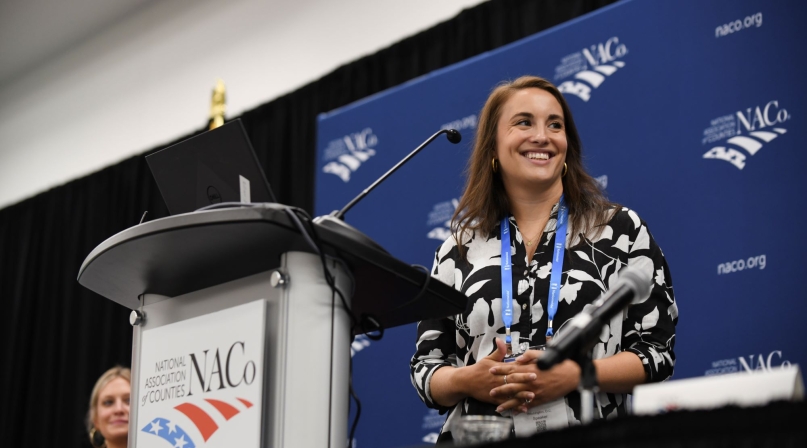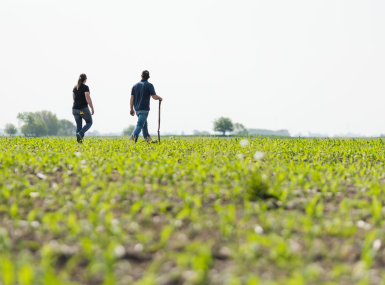DOT helps rural counties find funding, with deadlines approaching

Key Takeaways
Some say “roots” and others go with “rao-ts,” however rural county officials choose to pronounce it, the ROUTES Initiative — Rural Opportunities to Use Transportation for Economic Success — offers resources for them to make the most of federal funding.
All rural counties have a roads department, but far fewer rural counties have personnel who can spend their time writing grant applications and finding funding for projects beyond maintaining infrastructure, so ROUTES is designed to make federal programming more accessible.
“The bipartisan infrastructure law did provide a lot of money, $44 billion in fact, for rural communities. It’s great, but it’s also stressful and it’s a little overwhelming,” Lily Ballengee told the Rural Action Caucus July 13. She is a transportation planner in the U.S. Department of Transportation (DOT) Rural Transportation Policy Office.
“We want you to prioritize your time focusing on what matters to you instead of filtering through all of that” information that doesn’t pertain to rural counties, she noted.
The initiative collects DOT resources that apply to rural communities, offers direct technical assistance and is designed to be more accessible with understaffed counties in mind. ROUTES also a monthly email newsletter with funding updates.
“Often that [means] taking a very detailed resource and trying to condense it down to what matters most to rural, and in some cases, it’s developing specific resources for your communities alone,” Ballengee said.
Those resources include a rural grant applicant toolkit, which operates like a compendium of it takes to get a DOT discretionary grant and an explanation of what it means to present a “ready” project to the department for funding. It also explains post-award requirements.
“I’m sometimes told that getting the awards is the easy part figuring out to do with it after the end is the harder part and figuring out the reporting structure,” she said. “This helps give you some ideas of what to do and where to start.”
Along the same lines, the DOT Navigator helps walk applicants through the process, including how to buttress their efforts with data and where to find it. It also includes a Benefit-Cost Analysis spreadsheet template.
“I do a lot of rural and tribal debriefs with unsuccessful applicants and unfortunately data is often kind of one of those challenges — it could be the difference between a highly-rated project and a recommended project [that succeeds],” Ballengee said. “Compiling data can be hard for rural communities — it’s too costly, it’s time consuming. That’s not to say you don’t have to do any [data work] of your own, but hopefully this can be helpful.”
She touched on other DOT programs of interest to rural counties.
- The Rural and Tribal Assistance Pilot Program is a technical assistance program to help rural and tribal communities be more competitive in future applications. It’s currently funded for $25 million; there is no local match requirement, but it’s first-come, first-serve. “You can do everything from hire staff to retain technical, legal and financial advisors to do all those planning studies that are so important,” she said. The only thing is it’s no construction.”
- The Railroad Crossing Elimination Grant Program sets aside funding for rural and tribal, with an additional pot of money set aside for communities with less than 20 residents per square miles, all to enhance safety around at-grade rail crossings. Applications are due Aug. 23.
- The Reconnecting Communities Pilot Grant Program aims to improve access to daily needs including work, school, medical care, food, nature and recreation. The deadline is Sept. 30.
- Safe Streets and Roads for All funds road safety infrastructure programs and has an Aug 29 deadline.
- The Charging and Fueling Infrastructure Grant Program helps fund publicly accessible electric vehicle charging stations, along with other alternative fueling infrastructure, including hydrogen, propane and natural gas. Applications are due Aug. 28. The department also published a rural electric vehicle infrastructure toolkit, what Ballengee calls, “the first attempt, really, to figure out ‘What can rural communities do to get a bite of the electric vehicle apple?’”
Related News

White House and U.S. Department of Agriculture announce $12 billion in aid to farmers
On December 8, President Trump and U.S. Secretary of Agriculture Brooke Rollins announced a $12 billion farm aid package to help farmers manage market disruptions and rising production costs.

House lawmakers introduce bipartisan legislation to support World Cup local transportation needs
On December 2, U.S. Reps. Rick Larsen (D-Wash.-02) and Burgess Owens (R-Utah-04) introduced the Transportation Assistance for Olympic and World Cup Cities Act (H.R.6348), a bipartisan effort to strengthen local transportation systems in communities preparing to host major international sporting events

County Countdown – Dec. 1, 2025
Every other week, NACo's County Countdown reviews top federal policy advocacy items with an eye towards counties and the intergovernmental partnership.
